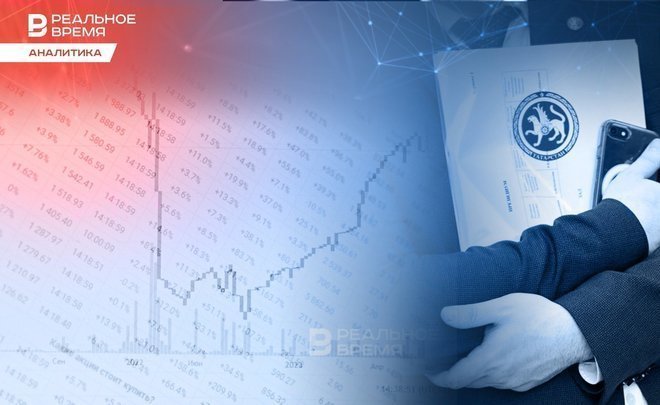Short of $4 trillion: how Tatarstan’s economy grows this year

The economy of Tatarstan is going to grow in 2023, according to the forecasts of the Ministry of Economy, by 2% — up to 3,9 trillion rubles. At the beginning of the year, the regional government had a task to increase GRP to 4 trillion rubles, but the current year turned out to be more difficult for Tatarstan than the past. In 2022, the economy, despite sanctions and a difficult economic situation, grew by 6%. This had been the best indicator in the last five years. Why the growth rate of the economy is slowing down — in the review of the analytical service of Realnoe Vremya.
According to the Ministry of Economy of Tatarstan, the volume of gross regional product (GRP) by the end of 2023 is going to amount to 3,9 trillion rubles, or 102% by 2022. Such data was presented at a meeting of the Cabinet of Ministers of the Republic of Tatarstan by Deputy Prime Minister of the Republic of Tatarstan — Minister of Economy of the Republic of Tatarstan Midkhat Shagiakhmetov.
In the total volume of GRP, 26% is mining, 17,5% is manufacturing, 10,4% is wholesale and retail trade, 7,7% is construction, 5,6% is transportation and storage, 4,3% is agriculture.
According to the forecasts of the Ministry of Economy, the volume of industry is going to amount to 4,5 trillion rubles, or 102%, agriculture — 292,3 billion rubles, or 87,5%, construction — 643,3 billion rubles, or 106,9%, retail trade — 1,3 trillion rubles, or 105,8%, investment — 959,9 billion rubles, or 102,1%. At the same time, industrial production, according to the estimate of 2023, occupies 45,7% of the share of the economy.
Midkhat Shagiakhmetov said that if by the end of 2023 the volume of shipped products is expected to be 4,5 trillion rubles, then in 2024 — 4,7 trillion rubles, in 2025 — 5,1 trillion rubles, in 2026 — 5,4 trillion rubles.
The gross regional product of Tatarstan by the end of 2022 increased by 6% to 3,7 trillion rubles. At the same time, last year's GRP growth was indeed unexpectedly high. This had been the best indicator in the last five years. In 2021, Tatarstan's economy grew by 3,8% to 3,3 trillion rubles, and earlier in 2020 it fell by 2,9%. The growth in 2019 was only 1%.
In 2022, the Russian economy was hit by unprecedented sanctions that restricted export and import operations, access to technology and provoked an increase in prices for goods and services. Tatarstan enterprises had to rebuild logistics chains and look for new markets. Nevertheless, the economy of the region not only survived, but also developed rapidly. Against the background of such success, the authorities of Tatarstan set a task for 2023 to increase the volume of GRP to 4 trillion rubles. However, it did not work out — the year 2023 turned out to be more difficult for a number of key industries of Tatarstan than 2022.

Why did the economy fall in 2020 and grow in 2022?
“The crisis conditions of 2020 and 2022 have a different nature. The decrease in Tatarstan's GRP in 2020 was due to the deterioration of the socio-economic situation against the background of crisis phenomena caused by the coronavirus pandemic and a decrease in oil production. Besides, the year 2020 was the first shock, adaptation to which required some time and new efforts, the damage was largely caused to the service sector (the volume of paid services decreased by 11,7%, the volume of retail trade — by 5,8%)," comments Vladislav Bukharsky, the junior director for sovereign ratings of Expert RA agency.
In 2022, sanctions and geopolitical pressure intensified, but to a certain extent it existed before. At the same time, operational measures were taken to combat the restrictions that had arisen.

The decrease in the expected GRP growth rates in the region in 2023 may be due to the high base of 2022.
Tatarstan's forecasts for 2023 look quite sober, which is confirmed by the dynamics of individual indicators for the past period of 2023. The industrial production index for January-August 2023 compared to the same period of the previous year amounted to 103,9%, the volume of construction work for the same period increased by 19,2%, retail trade turnover and the volume of paid services to the population increased by 8,6% and 7,4%, respectively. “In addition, the volume of investments in fixed assets for the 1st half of the year increased by 16,5% in comparable prices, which may give a certain positive impact on GRP by the end of this year, or at least in the following years," Vladislav Bukharsky predicts.
“In 2020, the pandemic played a role," explains Rustam Shayakhmetov, economist and head of R-Invest. “In 2022, the state, in connection with the special military operation, printed the kubyshka, and the money went to the economy. This is the income of the population associated with the defense complex and its participants.”

Government forecasts for 2023, in his opinion, are quite realistic, taking into account the expected accelerated development of the civil aircraft industry and the IT industry.